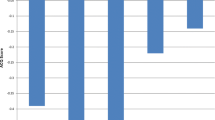Abstract
The placebo is much more than a control medicine in a clinical trial. The placebo response is the largest component of any allergy treatment and consists of two components: nonspecific effects (eg, natural recovery) and a “true placebo effect” that is the psychological therapeutic effect of the treatment. Belief in the beneficial nature of the treatment is a key component of the true placebo effect, and can be enhanced by factors such as interaction with the physician and the sensory impact of the treatment. Negative beliefs can generate a nocebo effect that may explain some psychogenic illnesses; this is the basis of much research in psychoneuroimmunology. An understanding of the placebo and nocebo effects is important for general allergy practice, and harnessing the power of the true placebo effect is a major challenge to modern medicine.
Similar content being viewed by others
References and Recommended Reading
Benson H, Friedman R: Harnessing the power of the placebo effect and renaming it “remembered wellness.” Annu Rev Med 1996, 47:193–199.
Harrington A, ed: The Placebo Effect: An Interdisciplinary Approach. Cambridge, MA: Harvard University Press; 1999.
Guess H, Kleinman A, Kusek J, Engel L, eds: The Science of the Placebo: Towards an Interdisciplinary Approach. London: BMJ Books; 2002.
Moerman D: Meaning, Medicine and the “Placebo Effect.” Cambridge: Cambridge University Press; 2002.
Evans D: Placebo: The Belief Effect. London: Harper Collins; 2003.
Shure N: The placebo in allergy. Ann Allergy 1965, 23:368–376.
Glover MT, Atherton DJ: A double-blind controlled trial of hyposensitization to Dermatophagoides pteronyssinus in children with atopic eczema. Clin Exper Allergy 1992, 22:440–6.
Van Cauwenberge P, Juniper EF: Comparison of the efficacy, safety, and quality of life provided by fexofenadine hydrochloride 120 mg, loratadine 10 mg, and placebo administered once daily for the treatment of seasonal allergic rhinitis. Clin Exper Allergy 2000, 30:891–899.
Juniper EF, Guyatt GH, Griffith LE, Ferrie PJ: Interpretation of rhinoconjunctivitis quality of life questionnaire data. J Allergy Clin Immunol 1996, 98:843–845.
Ernst E, Resch KL: Concept of true and perceived placebo effects. BMJ 1995, 311:551–553.
Eccles R: Placebo effects of antitussive treatments on cough associated with acute upper respiratory tract infection. In Cough, Causes, Mechanisms and Therapy. Chung KF, Widdicombe JG, Boushey HA, eds. Malden, MA: Blackwell Publishing; 2003:259–268.
Kienle G, Kiene H: Placebo effect and placebo concept: a critical methodological and conceptual analysis of reports on the magnitude of the placebo effect. Alternative Therapies 1996, 2:39–54.
Lee PC, Jawad MS, Hull JD, et al.: The antitussive effect of placebo treatment on cough associated with acute upper respiratory infection. Psychosom Med 2005, 67:314–317.
Eccles R: Mechanisms of the placebo effect of sweet cough syrups. Respir Physiol Neurobiol. 2006, 152:340–348.
Song C, Leonard BE: Fundamentals of Psychoneuroimmunology. Chichester, England: John Wiley and Sons; 2000.
Fleshner M, Laudenslager ML: Psychoneuroimmunology: then and now. Behav Cogn Neurosci Rev 2004, 3:114–130.
Blackwell B, Bloomfield SS, Buncher CR: Demonstration to medical students of placebo responses and non-drug factors. Lancet 1972, 1:1279–1282.
Hahn R: The nocebo phenomenon: scope and foundations. In: Harrington A, ed. The Placebo Effect: An Interdisciplinary Approach. Cambridge, MA: Harvard University Press; 1999:56–76.
Luparello T, Lyons HA, Bleecker ER, McFadden ER, Jr: Influences of suggestion on airway reactivity in asthmatic subjects. Psychosom Med 1968, 30:819–825.
World Medical Association: Declaration of Helsinki. Available at: http://www.wma.net/e/policy/b3.htm.
Author information
Authors and Affiliations
Corresponding author
Rights and permissions
About this article
Cite this article
Eccles, R. The power of the placebo. Curr Allergy Asthma Rep 7, 100–104 (2007). https://doi.org/10.1007/s11882-007-0006-2
Published:
Issue Date:
DOI: https://doi.org/10.1007/s11882-007-0006-2




